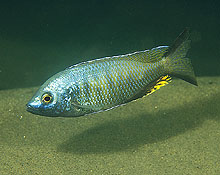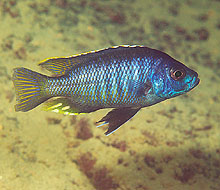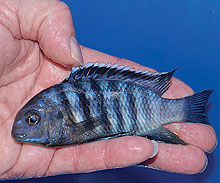WHAT'S NEW ACROSS THE WORLD
Select date in side bar to go to a What's New of previous issues
| What's New
©by Laif DeMason
If anyone has been reading this column over the last two decades, it is evident many of the “new” fish featured are no longer available from others regardless of source. As a commercial seller, I see definite patterns of sales for groups of fishes. Currently wild Tropheus of only certain varieties are selling in “stampedes”, then just as quickly not bought. It is like hobbyists are attracted to the “coolest” fish on the most recent internet video. My suggestion: Keep what you like, not necessarily what everyone else has!
Here’s “what’s new” on the cichlid scene: |
Lake Tanganyika
|
WHAT'S NEW: LAKE TANGANYIKA
|

The popularity of wild Tropheus has also swung to the T. brichardi varieties. Several have been imported, but one from Bulombora seems to be more sought after. Similar to the bold barred variety we imported from Ujiji years ago, the Bulombora’s color is more contrasting and bright.
|
Lake Victoria
|
WHAT'S NEW: LAKE VICTORIA
|

Recently some commercial producers in Florida have been selling Neochromis omnicaeruleus or Hap. ‘blue scraper’. Their fish has a piebald female and a male with an orangey pattern. I’m not sure where it originated. The shape does not exhibit the usual steeply curved forehead of the wild forms.
|
Lake Malawi

Malawi cichlid enthusiasts always seek the not often seen species. Lately some seasonal utakas have been exported; here Copadichromis sp. ‘mloto undu’ from Undu Point, Tanzania. This fish is not the old standby “mloto” (Cop. trewavasae)! Photo by A. Konings.
|

Another seasonal item that was exported lately, Copadichromis likomae from Chimate Reef, Tanzania. Another blue cichlid from Lake Malawi, but you will not see this fish very often offered for sale. Well, maybe not until next year at the same time… Photo by A. Konings.
|

Always a favorite for some Malawi hobbyists; cool and unusual predatory haplochromines. Here pictured, Hemiteaniochromis brachyrhynchus (Blue Spilopterus) is also collected from Chimate Reef. Usually offered in 6 to 8 fish quantities, be prepared to buy them all if you want to breed them. Photo by A. Konings.
|

Perhaps spurred by the interest in Tropheus, the many species and varieties of Tropheops from Lake Malawi have seen some interest of late as well. Pictured here is a male T. sp. ‘Higga’ (Blue Bar Higga Reef). Cichlids from this genus are typically “tough nuts” and so their aggression needs to be well managed!
|
Select date in side bar to go a What's New of previous issues |